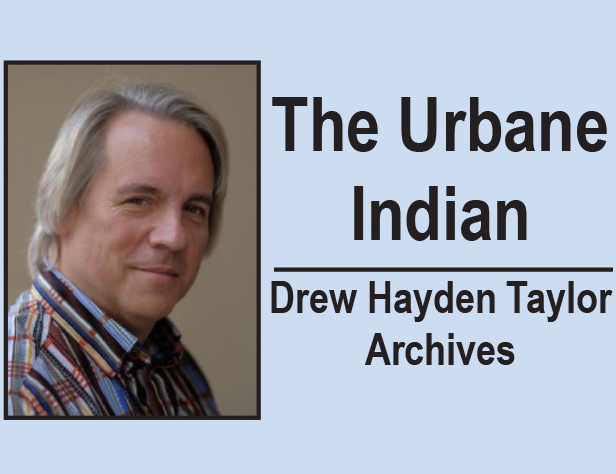
By Drew Hayden Taylor
Originally published in November 2013
Living in today’s society, it’s impossible to make it through the day without wading deep into the world of acronyms.
In the morning I listen to (and frequently work for) the CBC while eating my BLT. As a Native person I am familiar with DIAND and watch APTN when not explaining myself to the RCMP.
I’ve got RSPs at my TD, recommended by my CPA to prevent my bank account from becoming DOA. Sometimes it just makes you want to LOL while crying out OMG. Sometimes it’s insane.
I bring this up because recently I got a simple, two-line email invitation to speak at an academic function. The only information given told me it was a TCDSB FNMI student symposium.
Based on that, I didn’t have much to go on and I spent about 10 minutes deciphering it. The FNMI was fairly obvious–First Nation, Métis, Inuit–but the rest took a bit of effort. Was it from the Tuscaroran Card Dealers Society of Brampton? Or maybe the Tea & Coffee Distributors of Southern Britain? Possibly some organization called Treaty Connoisseurs Debating Sexy Bylaws. I was worried I’d have to take a class in acronyms.
Personally, I have nothing against acronyms. They were originally created to make longer phrases or technical terms more manageable and easier to remember. Over the years I have even created a few myself, out of necessity.
One of the most frequent questions most people of Aboriginal ancestry are asked is “Native, Indian, Aboriginal… what the heck should I call your people?” And to save time and effort, and because almost every Native person I know has a particular favourite, I just suggest people use the term NAFNIP (Native, Aboriginal, First Nations, Indigenous People).
It’s rather inclusive and covers most of the essential bases. In other situations, I have also used the term BIOC (Big Indian On Campus) to refer to popular and influential NAFNIPS you may come across. So they would be BIOC NAFNIPs. Think of them as the Alpha Indians. I am sure you know a few.
One of the more confusing uses of acronyms I have ever witnessed happened during a trip to Minnesota. I was in a car with some American BIOC NAFNIPS and we passed by a local diner that was advertising its special of the day: a BLGT sandwich, to which somebody in the car commented on what a politically correct and socially inclusive culinary salute it was to those with alternative sexual preferences.
This person was of course referring to the familiar acronym LGBT, which stands for lesbian, gay, bi-sexual and transgendered. It turns out the diner was advertising a less socially conscious lunch, merely a bacon, lettuce, guacamole and tomato sandwich. On occasion, acronyms can be dangerous and occasionally embarrassing.
But that was just the beginning. Let’s take a step up the acronym sexuality ladder. Somewhere out there, acronyms are getting together, breeding, getting bigger, stronger and more complex. I say this because LGBT is no longer accurate. In fact, it’s rather dated. It’s so 1990s.
One of the more detailed, inclusive, and politically correct (DIPC) acronyms currently being used these days is, and this is 100 per cent true, LGBTT2SIQQA. For those out there not hanging out in LGBTT2SIQQA bars, this stands for lesbian, gay, bi-sexual, transsexual, transgendered, two spirited, intersex, queer, questioning, asexual. Granted sexuality can be a complex issue but this acronym may need its own acronym.
It seems the days of asking if you prefer blondes or redheads have long since passed.
I just remember the simple days of yesteryear when acronym stories carried less social baggage. Remember way back when the Reform and the Conservative party merged in order to unite the right. They came up with a new name for the new political party: the Canadian Reform Alliance Party. It must have taken about a half hour or so before somebody must have clued into what would be appearing on their letterhead.
CRAP.
I’m just sayin’…
